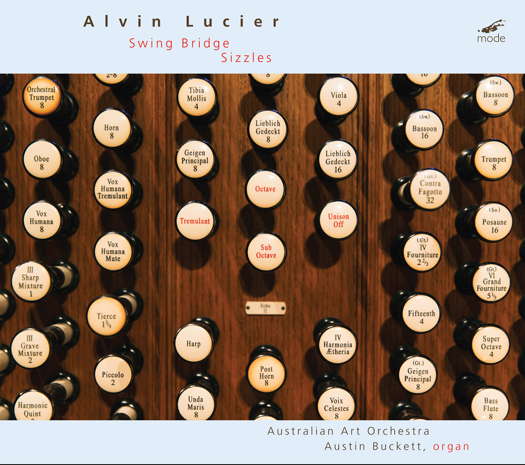 DISCUSSION: John Dante Prevedini leads a discussion about Classical Music and Politics, including contributions from Béla Hartmann and James Ross.
DISCUSSION: John Dante Prevedini leads a discussion about Classical Music and Politics, including contributions from Béla Hartmann and James Ross.
- Seiji Ozawa Hall
- Foundling Museum
- Shostakovich: Symphony No 12
- Peter Leadbitter
- The Lamb
- Moïse et Pharaon
- Västerås Symphony Orchestra
- Korngold: Theme and Variations
 SPONSORED: A Seasoned Champion of New Music. Argentinian-American pianist Mirian Conti in conversation with Andrew Schartmann.
SPONSORED: A Seasoned Champion of New Music. Argentinian-American pianist Mirian Conti in conversation with Andrew Schartmann.
All sponsored features >>

The Space as an Instrument
JOHN DANTE PREVEDINI listens to the fine sonic details of music by the late Alvin Lucier
'... a fitting epilogue to Lucier's long and distinguished career ...'
Swing Bridge; Sizzles is the recent release from Mode Records of two works by the late American composer Alvin Lucier: Swing Bridge (2017) and Sizzles (1997). The pieces heard on the album are performed on the Grand Organ of the Melbourne (Australia) Town Hall by Austin Buckett with the Australian Art Orchestra, who commissioned Swing Bridge specifically for this project. The hour-long release is available in both CD and digital format, and it includes a booklet with liner notes from producer Peter Knight. According to Knight, Lucier remained closely involved with the production up until his passing in December 2021; hence the album, though posthumous, remains a faithful expression of his wishes.
The three-track album presents the single-movement Swing Bridge for organ and chamber orchestra sandwiched between two takes of the single-movement Sizzles for solo organ in a specially modified acoustical space. Because Lucier had favored takes five and six of the latter from the sessions, as explained by Knight, both are included here and are simply named as 'Sizzles (take 5)' and 'Sizzles (take 6)' in the track listing.
Sizzles, according to the liner notes, is written for a solo organ with various drums placed throughout the performance space; in turn, across each drum head are scattered different dried legumes or small candies. The intent is that, during the performance, the sounds of the organ cause the different drum heads to rattle through sympathetic vibration, resulting in a range of percussive effects. Having two contrasting takes of the piece on the album allows us to get a sense of the array of realizations that are possible within Lucier's parameters. This is true not only in terms of the physical placement of the drum heads and scattered materials in the acoustical space, but also in terms of the organist's realization of pitch, dynamics and durations of sonorities.
Listen — Alvin Lucier: Sizzles Take 5
(MOD-CD-312 track 1, 0:00-0:30) ℗ 2023 Mode Records :
In both takes, the performance assumes the broad shape of a crescendo, starting with the pedal notes of the organ in a low dynamic and gradually adding upper registers. The precise realization of each of these parameters is different, however, between the two takes; while 'take 5' uses smoother transitions to create a continuous increase in volume and pitch span, 'take 6' employs more of an abrupt plateau effect as successive notes are layered on top of one another. The latter is also slightly shorter at twelve minutes (versus thirteen and a half in 'take 5'). Thus, the piece would appear to allow considerable flexibility in the duration of each sonority as interpreted by the organist. While this is not a recording premiere of Sizzles, Knight points out that all previously released recordings of this piece have been from concert performances. This recording is novel in that it shows the piece in a studio-style setting, allowing us to hear a purer and higher-fidelity realization of Lucier's sonic vision.
Listen — Alvin Lucier: Sizzles Take 6
(MOD-CD-312 track 3, 0:00-0:30) ℗ 2023 Mode Records :
Swing Bridge, the middle track on the album, is scored for voice, two trumpets, two violins, cello, contrabass and prepared organ, the specific modifications to the latter involving the insertion of mechanisms that allow the pitches of selected pipes to be controlled by hand. As Knight explains in the liner notes, different performance participants have control over different modified pipes. The audible result of this during performance is that pitches slide up and down on different organ notes at different rates, creating the effect of a constantly undulating sea of sonorities with dissonant beat frequencies emerging and subsiding. Meanwhile, the other instruments blend in timbrally with the upper-middle registers of the organ, creating a unified sound mass that is sustained in a broad dynamic arch form over the course of the thirty-six-minute performance.
Listen — Alvin Lucier: Swing Bridge
(MOD-CD-312 track 2, 0:00-0:30) ℗ 2023 Mode Records :
In all three of the realizations on this album, Alvin Lucier's music explores the subliminal emergence of rhythm from pitch itself. In both takes of Sizzles, polyrhythms arise organically from the interplay between contrasting sympathetic vibrations of small objects rattling on drum heads, while Swing Bridge explores the rhythmic effect of dissonant beat frequencies when pitches slowly slide into and out of tune with one another. Lucier's close involvement with the project and Peter Knight's detailed description of the process make this album a valuable and authoritative encapsulation of the composer's practice in its latest stages. Additionally, all of the unusual acoustical parameters make for a listening experience that is probably best enjoyed with headphones in a quiet space, as there are many fine sonic details that might otherwise be too easily missed. In summary, I consider Swing Bridge; Sizzles a fitting epilogue to Lucier's long and distinguished career as a pioneer in the musical possibilities of acoustical environments, or the space itself as an instrument. This album is a document that at once illuminates some of his final contributions to the field while also upholding his groundbreaking example for a new generation of experimental acoustic composers.
Copyright © 8 July 2023
John Dante Prevedini,
Connecticut, USA



